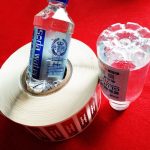
Application of Liquid RFID Electronic Tag
[ad_1]
As the Internet of Things continues to mature and its applications become more and more extensive, the actual scene requirements that follow continue to promote the further development of the Internet of Things technology. Because the radio frequency signal of RFID technology has interference to human body, metal and liquid. The human body absorbs radio frequency microwaves, and liquids and metals cannot penetrate radio frequency signals. Therefore, the application of RFID radio frequency will be interfered by metals and liquids and cannot be used in its fields. Only by overcoming these technical difficulties can the Internet of Things be implemented on a large scale!

At present, various anti-metal and flexible anti-metal tags have been put into use, such as metal RFID asset management, metal equipment, construction and so on. With the rise of unmanned retail, breaking through the restrictions of liquid beverages on UHFRFID radio waves is an urgent problem in the Internet of Things industry.
Some R&D teams have successfully developed new RFID electronic tags, innovated the labeling method of RFID tags, and used flag tags to avoid the impact of liquids on RFID. This liquid label can be directly pasted on the surface of liquid non-metal packaging bottles, successfully breaking through the restrictions on the use of RFID technology in liquid products!
The tag expands the application range of RFID and at the same time provides more convenient and reliable technical support for the development of unmanned retail. Conventional superscript, concise and convenient: adopt the conventional superscript method, which is concise and efficient. Not only that, behind the conventional superscripting method is to provide a basis for the standardized implementation of RFID label superscripting, and to remove obstacles to the development of automatic labeling technology. Small in size, beautify the display, the RFID tag is pasted on the surface of the product, and the size is similar to that of the conventional bar code, which has little impact on its display. It does not need to reserve a label position in the display, which improves the aesthetics and space utilization. Enhancing the stability of the technology. During the use of the flag label, consumers will unintentionally pick and place the product, which will cause the RFID label to fold, which will affect the performance of the label. The liquid label can avoid this situation and increase the reliability of the technology. sex.
The successful research and development of liquid labels will bring more application value while meeting the existing unmanned retail needs. This means that RFID can be used to collect a large amount of consumer data on various beverages, liquid cosmetics, alcohol and other commodities. . Especially in the field of cosmetics, the category of liquids accounts for a relatively large proportion of its products, and consumer preferences will have a great impact on its sales. Using RFID, combined with a reader, can record real consumer behavior data such as sample trial times and duration, and analyze the actual sales situation, which can provide data support for the formulation of sales strategies.
The successful research and development of liquid RFID electronic tags is not only for the Internet of Things industry, but also a step up in the development of RFID, allowing the management of metal and liquid items to join the RFID Internet of Things world again. As a data carrier, RFID electronic tags can perform many functions such as identification, item tracking, and information collection. At present, RFID electronic tags have been used in a wide range of fields. The RFID system consisting of RFID electronic tags, RFID readers, RFID antennas and application software is directly connected to the corresponding management information system. Perform intelligent automatic collection and recognition functions.
[ad_2]






